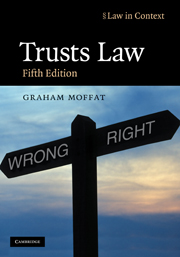Book contents
- Frontmatter
- Contents
- Preface to the fifth edition
- Acknowledgments
- Table of abbreviations
- Useful websites
- Table of statutes
- Table of statutory instruments
- Table of cases
- 1 Trusts introduced
- 2 The evolution of the private express trust
- 3 Taxation, wealth-holding and the private trust
- 4 Creating the trust – I
- 5 Creating the trust – II
- 6 Trusts and public policy
- 7 Flexibility in relation to beneficial entitlement
- 8 The taxation of private trusts
- 9 An introduction to trustees and trusteeship
- 10 Aspects of the management of trusts
- 11 Trusteeship, control and breach of trust
- 12 Implied trusts and the family home
- 13 Trusts in commerce I: occupational pension schemes
- 14 Trusts in commerce II: commerce and equitable remedies
- 15 Trusts in commerce III: commerce, credit and the trust
- 16 Trusts in commerce IV: fiduciary relationships, commerce and the trust
- 17 Trust, contract and unincorporated associations
- 18 An introduction to the law of charity
- 19 A legal definition of ‘charity’
- 20 The regulation of charities
- Index
8 - The taxation of private trusts
- Frontmatter
- Contents
- Preface to the fifth edition
- Acknowledgments
- Table of abbreviations
- Useful websites
- Table of statutes
- Table of statutory instruments
- Table of cases
- 1 Trusts introduced
- 2 The evolution of the private express trust
- 3 Taxation, wealth-holding and the private trust
- 4 Creating the trust – I
- 5 Creating the trust – II
- 6 Trusts and public policy
- 7 Flexibility in relation to beneficial entitlement
- 8 The taxation of private trusts
- 9 An introduction to trustees and trusteeship
- 10 Aspects of the management of trusts
- 11 Trusteeship, control and breach of trust
- 12 Implied trusts and the family home
- 13 Trusts in commerce I: occupational pension schemes
- 14 Trusts in commerce II: commerce and equitable remedies
- 15 Trusts in commerce III: commerce, credit and the trust
- 16 Trusts in commerce IV: fiduciary relationships, commerce and the trust
- 17 Trust, contract and unincorporated associations
- 18 An introduction to the law of charity
- 19 A legal definition of ‘charity’
- 20 The regulation of charities
- Index
Summary
Tax planning and the trust
What to the legislator and parliamentary draftsman can appear as a trust problem may simultaneously be to the tax adviser a means of achieving a tax planning objective. In this first section we re-emphasise the peculiar facets of the trust that create this situation.
The basis of the trust's attraction for tax planning is founded on the fundamental division of ownership between nominal title, benefit and control.
P A Lovell ‘Reflections on a Unified Estate and Gift Tax Regime’ [1974] BTR 141 at 157–158
The trust as a device depends for its success on the correct interplay between three basic concepts: the ownership of property, the management of the same, and the beneficial interests therein and enjoyment thereof, …
Discretionary trusts, … are … problematic for, whilst ownership and management are vested in the trustees, the property is, in a material way, ownerless; the interest in possession is absent and the distribution of the benefits accruing from the trust property are distributable, subject to any powers of accumulation extant, at the discretion of the trustees.
… Even in those trusts where a beneficial interest in possession in income has been created, it may nevertheless be possible to combine such income enjoyment with an element of capital expectancy. Thus a beneficiary may be given a right to income at the same time as the trustees are given a power, should such be considered appropriate, to apply the capital, by outright transfer or otherwise, for the benefit of the same income beneficiary.
- Type
- Chapter
- Information
- Trusts LawText and Materials, pp. 371 - 419Publisher: Cambridge University PressPrint publication year: 2009



